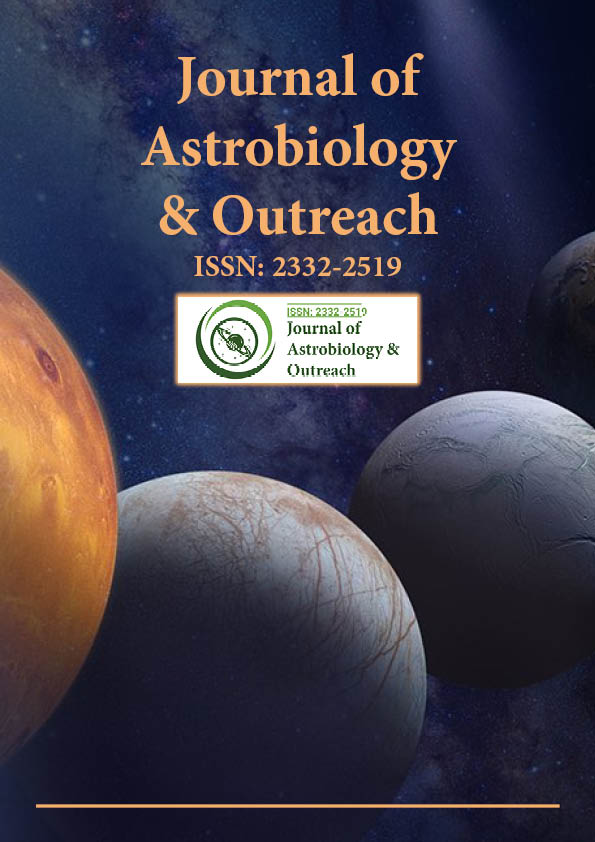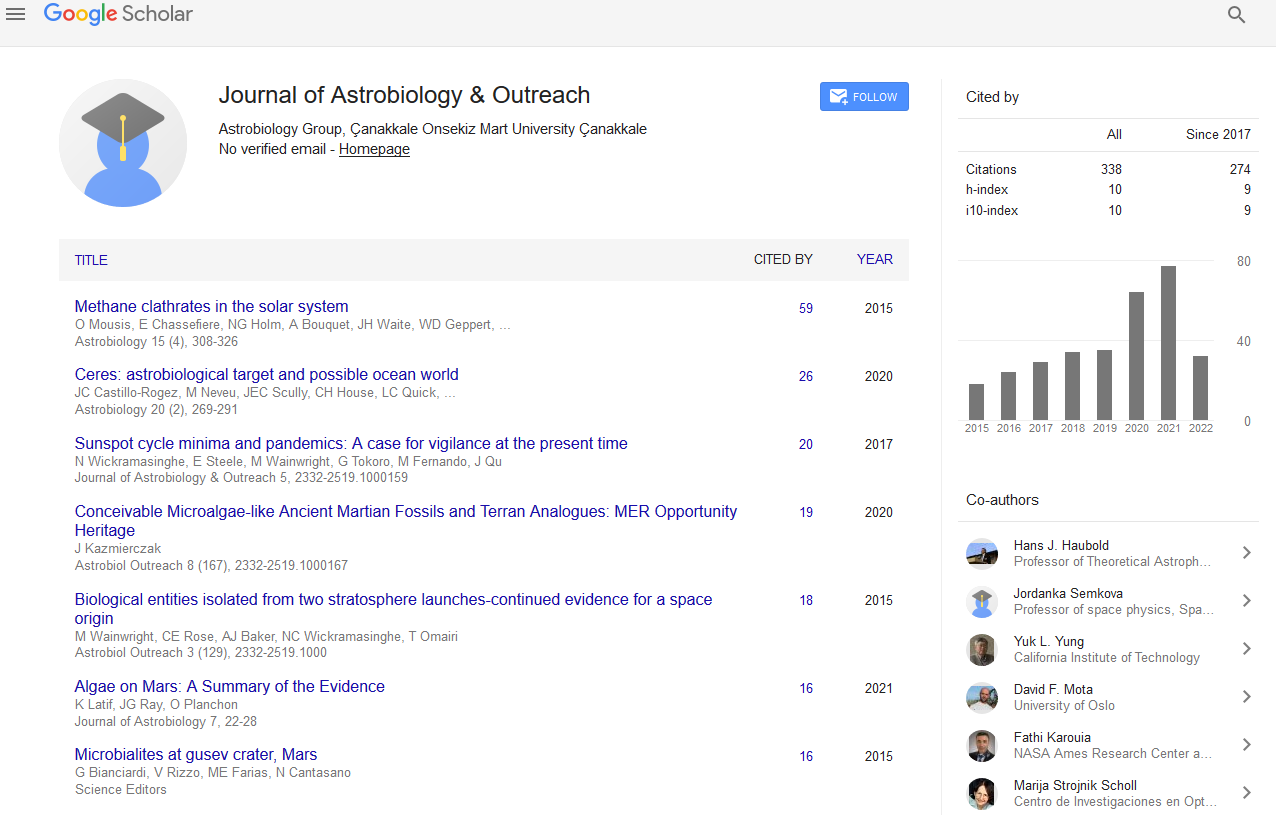Indexed In
- Open J Gate
- Academic Keys
- JournalTOCs
- RefSeek
- Hamdard University
- EBSCO A-Z
- OCLC- WorldCat
- Google Scholar
Useful Links
Share This Page
Journal Flyer

Open Access Journals
- Agri and Aquaculture
- Biochemistry
- Bioinformatics & Systems Biology
- Business & Management
- Chemistry
- Clinical Sciences
- Engineering
- Food & Nutrition
- General Science
- Genetics & Molecular Biology
- Immunology & Microbiology
- Medical Sciences
- Neuroscience & Psychology
- Nursing & Health Care
- Pharmaceutical Sciences
Perspective - (2023) Volume 11, Issue 5
Exploring Cosmochemistry and Decoding the Chemical Pattern of the Universe
Etienne Deloule*Received: 22-Aug-2023, Manuscript No. JAO-23-24780; Editor assigned: 25-Aug-2023, Pre QC No. JAO-23-24780(PQ); Reviewed: 08-Sep-2023, QC No. JAO-23-24780; Revised: 15-Sep-2023, Manuscript No. JAO-23-24780(R); Published: 25-Sep-2023, DOI: 10.35248/2332-2519.23.11.314
Description
Cosmochemistry, a captivating and complex field of study, delves into the composition and origin of celestial bodies, offering an interesting drive through the chemical blend of the cosmos. This interdisciplinary science interweave chemistry, astronomy, and astrophysics to unlock the confidential of our universe's elemental makeup. In this exploration, they start on a cosmic odyssey, exposing the unexplainable of stardust, decoding the language of stars, and understanding the profound impact of cosmochemistry on our understanding of the cosmos.
One of the most enchanting aspects of cosmochemistry is the investigation of stardust-tiny particles that have driven through the cosmos, carrying the story of cosmic evolution. Stars, those celestial furnaces, forge elements through nuclear fusion. As these stars reach the end of their life cycles, they release stardust into space, dispersing a rich assortment of elements. These particles, often minuscule in size, become the components of planets, moons, and even life.
Cosmochemists careful analyze meteorites, comets, and interstellar dust to expose the elemental fingerprints left by stars. Every particle of dust contains a narrative about cosmic alchemy. the processes that occurred within stellar cores and the fiery important of supernovae. By decoding the chemical signatures of stardust, scientists gain insights into the conditions that prevailed during the formation of our solar system and beyond.
Beyond stardust, cosmochemistry extends its reach to examine the chemical composition of celestial bodies. Spectroscopy, a powerful tool in the cosmochemist's arsenal, enables the analysis of light emitted or absorbed by objects in space. By studying the unique spectra produced by different elements, researchers can identify the presence and abundance of specific elements in stars, galaxies, and nebulae.
Stars, those luminous light scattered across the cosmos, emit light that carries valuable information about their composition. Cosmochemists use spectroscopy to analyze the spectra of starlight, revealing the elements present within a star and their relative abundances. This method allows scientists to understand the life cycles of stars, from their birth in nebulae to their demise in supernova explosions.
Cosmochemistry is akin to decoding a celestial language written in the atomic signatures of stars. The elements present in stars provide important clues about the conditions that prevailed during their formation. Hydrogen and helium, the primordial elements, dominate the early stages of stellar evolution. As stars age and progress through their life cycles, heavier elements such as carbon, oxygen, and iron are forged through nucleosynthesis processes.
Cosmochemistry takes us on a chemical odyssey, exploring the origins of elements from largest particles. This drive encompasses the birth of elements in the aftermath of the Big Bang, the fusion reactions within stellar cores, and the distribution of elements in galaxies and intergalactic space. The chemical evolution of the universe unfolds through complex processes, each contributing to the rich diversity of elements observed today.
Cosmochemistry not only enriches our understanding of the cosmos but also holds implications for the search for extraterrestrial life. The study of chemical compositions in our solar system and beyond provides valuable insights into the potential habitability of other planets and moons. Understanding the distribution of key elements and organic molecules is essential in assessing the conditions conducive to life beyond Earth.
In the study of cosmochemistry, scientists resolve the unexplainable of the universe by decoding the chemical mosaic woven across the cosmos. From the microscopic grains of stardust to the colossal explosions of supernovae, each element tells a story of cosmic origins and evolution. Cosmochemistry not only deepens our understanding of the universe but also poses profound questions about our place in the vast cosmic expanse.
Citation: Deloule E (2023) Exploring Cosmochemistry and Decoding the Chemical Pattern of the Universe. J Astrobiol Outreach. 11:314.
Copyright: © 2023 Deloule E. This is an open-access article distributed under the terms of the Creative Commons Attribution License, which permits unrestricted use, distribution, and reproduction in any medium, provided the original author and source are credited.

